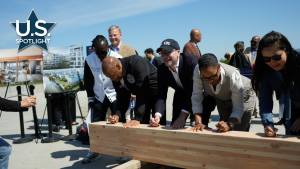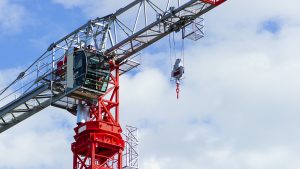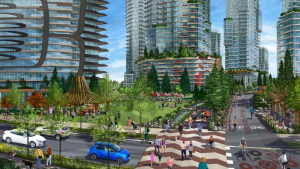The George R. Brown Convention Center (GRB) in Houston has been described as “a 1.1-million-square-foot behemoth” anchoring the 60-acre convention district on the east side of the city’s downtown.
The area is about to see significant change. The project team for a multi-year, $2 billion redevelopment of the GRB Center and surrounding area was named last month by the Houston Mayor’s
Office and Houston First Corporation, the city’s economic development group, which are overseeing the overall project.
Hines will be the development manager, Populous the architect of record, and Jacobs Advance Planning Group the landscape architect. Gilbane Building Company and Flintco Construction will act as joint construction managers.
“This project is truly transformative for downtown Houston, a lasting legacy that will solidify our position as a top-tier convention and entertainment destination,” said Mayor John Whitmire.
“Most importantly, we are creating a space that will build community, foster connection and shape the future of Houston.”
Construction on phase one, dubbed GRB South, will begin this year and is scheduled to open in 2028.
In a press release, Houston First said phase one will consist of a 700,000-square-foot expansion of the GRB while also providing access to the nearby Toyota Center arena, home to the Houston
Rockets of the NBA, via a new 100,000-square-foot pedestrian plaza. It will further serve as a connection point to future phases of the plan, anticipated for 2038 completion, that will redefine downtown’s eastern edge and link the area’s major facilities and amenities with new public spaces.
Phase one will include two new exhibit halls totalling 300,000 square feet plus a 50,000 square foot multi-purpose hall. Also planned are a 25,000 square foot atrium hall, new dining and retail spaces, and an 80,000-square-foot ballroom, described as “the largest in Texas,” that offers “panoramic views of downtown Houston.”
The new structure will have a slatted wood roof, a naturally lit central foyer, and other design elements “inspired by Houston’s bayous and native prairie landscape, featuring natural tones, warm wood accents and vegetation throughout.”
Other environmental initiatives include low-carbon construction materials, high-efficiency building systems with rainwater collection and water-reduction strategies, and rooftop native plantings. PV solar array integration is also under consideration, Houston First says.
“These efforts will enhance the city’s resilience and create an inclusive gathering space for generations of Houstonians.”
The 60-acre convention district first took shape when the GRB Convention Center opened in 1987. Multiple expansions and new buildings have since been built to meet demands for larger, more advanced facilities. The first was in 2003 when the GRB itself added 800,000 square feet and then again in 2016 with a major renovation that created the Avenida Houston Plaza and connected the GRB to the 12-acre park Discovery Green that opened in 2008. Other large buildings and facilities also opened during this time, including the Hilton Americas–Houston Hotel and the Toyota Center, both in 2003.
A 60-block masterplan for the convention district was issued in 2011 by global architects Gensler. The firm says the 2011 plan, “included recommendations for a district-wide strategy addressing land acquisition/parcel assemblage, public policy changes and investment incentives, public/private partnerships, infrastructure improvements and phased development strategies.”
Gensler reissued the plan this year, describing it as, “a best-case scenario for the public/private development of downtown Houston’s convention district.”
Gensler envisions a vibrant, economically sustainable district of residential, hotel, office, retail and dining and entertainment development that capitalizes on future east-west transit lines of the Metro light rail and existing public spaces.
The GRB expansion will be undertaken in parallel with the I-45 North Houston Highway Improvement Project, one of the largest infrastructure projects in Texas. Co-ordination between the GRB expansion and the $13 billion I-45 project is regarded as essential for the convention center’s viability as the project takes shape over the next several years. Nevertheless, there is ongoing local controversy concerning the impact of street closures and relocations on area residents and businesses in the district.
Funding for the required $2 billion is not expected to hit Houston taxpayers hard, thanks to Whitmire. When acting as a state senator, he authored State Bill 1057 which allows Houston to use increased taxes on downtown hotels to fund such major developments.












Recent Comments
comments for this post are closed